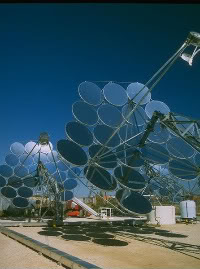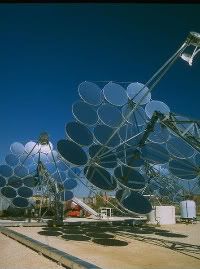Renewable Energy and Basic Physics


“Craig, do you know if a Stirling engine would be more efficient than making steam for a turbine?”
To which I reply:
I don’t know know much about Stirling engines; I need to learn about these. But it sounds like you may be comparing apples and oranges.
I’m sure you’re aware that devices that simply store energy (e.g., molten salt, batteries, capacitors) and devices that convert energy form one form to another (e.g., motors, turbines) are two different things. And as far as the latter is are concerned, electric motors, even using the technology of the very first ones 120+ years ago, are quite efficient; in fact, the AC induction motors that are used in today’s electric vehicles are close to 90% efficient. What’s not to like about that?
Thus, it seems to me that the real question is how to generate, store, and distribute the electricity. Coincidentally, I was writing my book’s chapter on basic physics last night, in which I noted the following about the conservation of energy:
Once one really wraps his wits these basic ideas, one is in a terrific position to understand most discussions of energy. Here are two examples to make this clear:
Hydrokinetics: Every day, the energy from the sun evaporates water into steam that is later condensed into clouds, the precipitation from which forms rivers, some of which are in high altitudes. The kinetic energy of the water flowing back downhill can be converted into electrical energy. But the conservation of energy tells us that the most electricity one can possibly hope to generate from this water is the potential energy it had before it started to flow (which equals the weight of the water times the height of the elevation from which it fell). This is for this reason that hydrokinetics cannot provide a significant amount to the overall energy picture, regardless of how many dams, how efficient the turbines, etc.
Solar: On the other hand, the earth receives 6000 times more energy from the sun every day than mankind currently uses for all its purposes: transportation, heating, air conditioning, etc. Put another way, if we had the capability of capturing and distributing 1/6000th of the sun’s energy, we would not need to burn another lump of coal, spilt another atom, or pump another ounce of gasoline. This fact alone forms the rationale for our interest in solar energy.
I encourage readers to review all assertions about different forms of power generation — renewable or otherwise – to this discussion on the conservation of energy. When someone says, “This car runs on water,” ask yourself: water? Isn’t water already “burned” hydrogen and oxygen, i.e., the result after these two elements release energy by joining together? That’s like saying, “Let’s build a fire using those ashes for fuel.” Sorry, they’ve already been burned, meaning that the chemical energy that was once stored in the carbon bonds of the wood has already been converted into the heat, light, and sound of a fire. The ashes are the low-energy result of that process.
I got an email from a friend announcing a miracle car that runs on air. As it turns out, it actually runs on compressed air. The energy required to compress the air is stored in a tank and converted into kinetic energy. Trust me, there is not one bit of energy delivered to that car’s wheels that didn’t going into compressing the air in the first place.
At the end of the day, I think the energy direction of the planet is very clear:
Generation: solar, especially concentrated solar power (CSP).
Storage: molten salt (Note that storage is somewhat less important for solar than say, wind, as solar tends to be generated in congruity with times of peak need). Note also that solar it’s already heat energy; there is no need to convert it to something else.
Transmission: High voltage direct current (HVDC). This requires a build-out of our ancient power grid, but we need to do that anyway.
Thanks again for writing, Peter. I hope this was useful.

[…] only piece you’re missing, I feel, is solar thermal / concentrated solar power (CSP) as described at the bottom of the […]